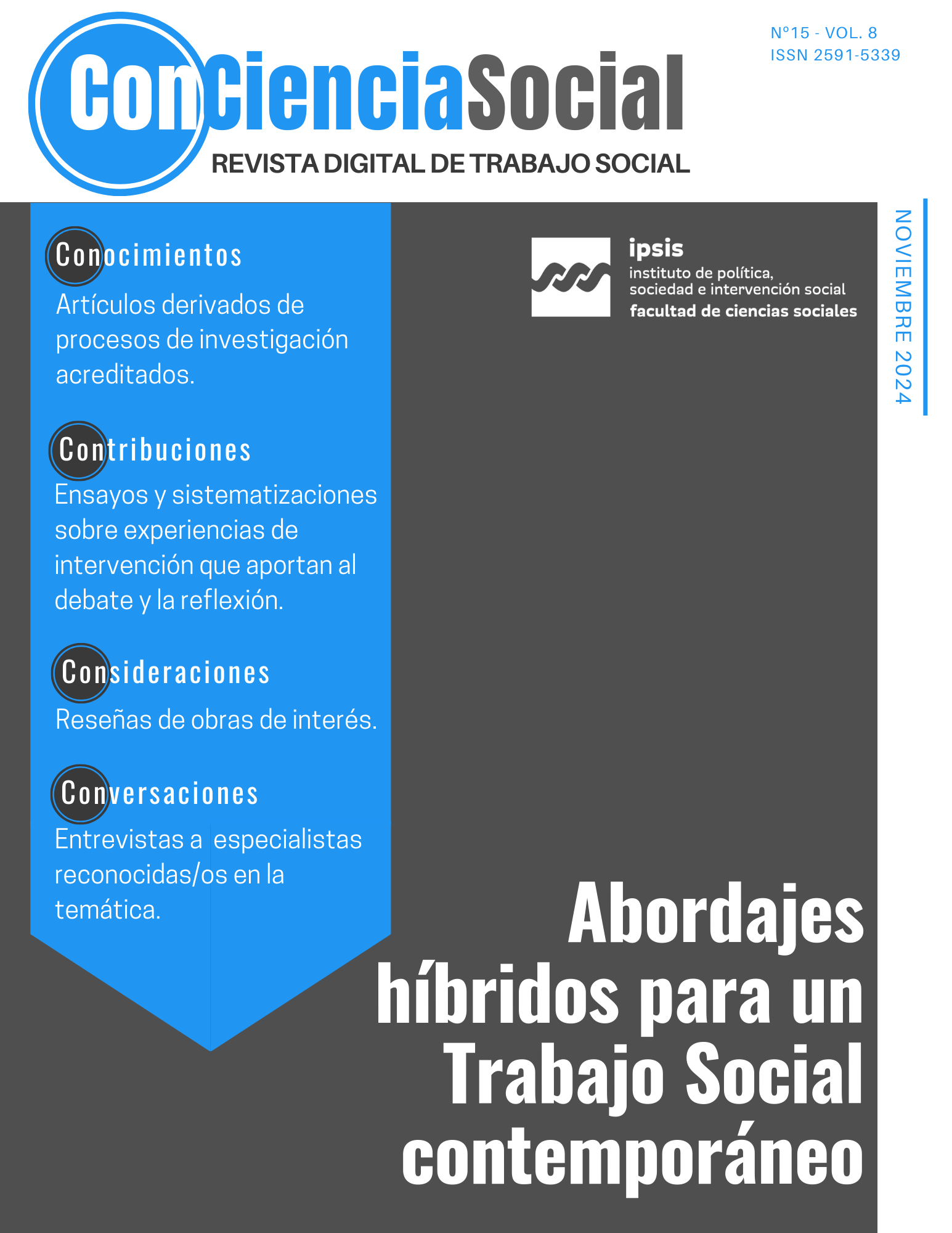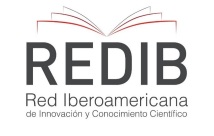Editorial
Keywords:
editorial, nro15, abordajes híbridos, trabajo social contemporáneoAbstract
Issue 15 of ConCienciaSocial, entitled Hybrid Approaches for a Contemporary Social Work, invites us to reflect on the incessant transformations of disciplinary practices in theoretical, but also political terms. We find ourselves in a historical moment that challenges the ways of thinking and doing Social Work, where the boundaries between the physical and the virtual, the local and the global, the historical and the emergent, seem to blur more and more. This phenomenon, which can be understood through the concept of hybridity proposed by authors such as Néstor García Canclini, Homi K. Bhabha or Stuart Hall, is the starting point of a fundamental debate to understand how the Social Sciences -and Social Work in particular- are inscribed in a juncture that challenges our readings of how the social is configured today.
Hybridity, understood as the coexistence and intertwining of cultural, social and technological elements, poses a challenge, but also an opportunity. According to García Canclini, this hybridity is understood as a process in which the modern and the traditional overlap, creating new forms of belonging and meanings (Canclini, 1995). This approach is key to rethink the practices of Social Work, which must confront the new languages, environments and devices that shape our reality. Bhabha, for his part, speaks of the hybrid as a “third dimension”, as inhabiting the edges of an intermediate, interstitial reality, in a borderline existence (Bhabha, 2007). In this in-between space, Social Work can develop innovative strategies that allow both the defense and protection of the rights of communities, as well as resistance to the power structures that continue to shape our societies. Along these lines, Stuart Hall, when speaking of fluid and contingent cultural identities, invites us to consider how social intervention practices must also be flexible and open to transformation (Hall, 2010).
The articles presented in this issue address precisely these issues, from diverse critical and methodological perspectives. Hybridity is not only a subject of study, but an epistemological necessity to understand the transformations that are happening at an accelerated pace. The epistemologies that have historically characterized Social Work need to be articulated with those emerging from contemporary demands. In this sense, some questions inhabit us: how can we, from Social Work, respond to a present that is no longer only physical or exclusively virtual, but a mixture of both? What are the implications of these new forms of relationship for thinking about our strategies of informed intervention?
This dialogue between the traditional and the contemporary, between the in-person and the virtual, challenges us to (re) invent and (re) create intervention strategies that respond to the complex problems of this time. In a scenario where hybridity imposes itself as a verifiable reality, this 15th issue of ConCienciaSocial invites us to think creatively, to hybridize our own practices and to build a contemporary Social Work that is capable of dialoguing both with its historical roots and with the unprecedented challenges we face.
The influence of technology on Social Work interventions is undeniable and forms a central part of the hybridization processes that our discipline is undergoing. Artificial intelligence, digital platforms, social networks and virtual environments are radically transforming the way in which links are established, resources are accessed and intervention strategies are implemented. These tools, which initially may have seemed alien or even contrary to the traditional forms of our work, today appear as indispensable means to build bridges with diverse populations and to intervene in contexts where face-to-face presence is no longer the only option. We have been observing how technologies not only modify the methods of intervention, but also the ways of building knowledge and generating empathy, by allowing us to create virtual spaces that reflect the dynamics of everyday life.
However, this transformation is not free of tensions: it forces us to question how ethical-political perspectives are sustained and how the balance is constructed between proximity and respect for singularity in interventions, and surrogate understandings in the transformation of the work society and the guarantee of care. It also challenges us to problematize the tendency of certain paradigms and political discourses towards robotized automation and artificial intelligence, which gradually positions and displaces the face-to-face human link, which remains and will continue to be crucial in the practice of Social Work.
On the other hand, we consider it important to problematize the fundamental role that face-to-face training continues to play in Social Work. Although technology has expanded our intervention and training capabilities, we cannot overlook the irreplaceable value of the pedagogical and didactic experience of the encounter. Humanity, who we are and who are les otres, the cultural and the political have been built from stories around the fire and the hearth, in the group, sharing the word, building collectively. In the classroom, the encounter between teachers and students creates a space for dialogue and collective construction that goes beyond the transmission of knowledge (Freire, 1997). It is in these face-to-face, multidimensional, multi-sensory interactions that incarnate learning takes place, in which gestures, emotions and active listening allow for a deeper understanding of the social issues we address. And it is in the experience of pre-professional internships that the acquired knowledge and skills are put into action.
Social Work, as a discipline focused on the complexity of human relationships and the necessary interventions to overcome the obstacles to the daily reproduction of existence, is nourished by these experiences that can only be captured and generated by the senses and shared presence.
The possibility of observing in real time the reactions of others, of discussing situations and approaches with the richness of interaction - not mediated by screens - is fundamental to train professionals who are sensitive to interpersonal dynamics and the contexts in which social practices unfold. Paradoxically, this need for the face-to-face also invites us to ask some questions: How do we balance the growing virtualization of teaching with the importance of experiential training in the classroom? How do we maintain the rigor implicit in our academic curricula and the depth of face-to-face training, without devaluing the possibilities that technology offers us? Hybridity in the teaching-learning process and in the professional practice of Social Work invites us to rethink the complementarity between the virtual and the face-to-face, recognizing that both dimensions, far from excluding each other, can mutually enrich each other when handled in a critical and conscious manner (Castells, 2000).
At the current juncture, technological innovations and social crises pose significant challenges for the field of social sciences and, in particular, for Social Work. The articles in this issue of ConCienciaSocial highlight the need to rethink our practices in an increasingly digitized world, where traditional methodologies are challenged by the imminent hybrid reality we face.
The article by Artazo, Eula and Parano explores the profound transformations that technological innovations are causing in the social sciences and their impact on social intervention. Based on a report on the intersection between social problems and technology at the Faculty of Social Sciences of the National University of Córdoba (UNC), the authors address how digitization and the use of big data have contributed to accentuate contemporary structural inequalities. They stress the importance of ethical and critical vigilance in social research, highlighting the need to integrate hybrid epistemologies and methodologies to address the challenges presented by this new reality. In a similar approach, Camejo, Carballo and Vecinday reflect on the growing incorporation of information and communication technologies (ICTs) in the management of social assistance policies in Uruguay, accelerated by the pandemic. They analyze how the automation of tasks transforms both professional practices and power structures in Social Work, which requires new epistemologies and methodologies to face contemporary challenges.
The COVID-19 pandemic forced social workers to adapt to new realities. Conrero, in his analysis, describes how these professionals in health centers assumed unprecedented responsibilities, such as performing swabs and using technologies to maintain contact with the people they assisted. This context raises ethical dilemmas, since many of these tasks were not part of their training. Thus, the need arises for Social Work to reinvent itself, combining traditional approaches with new tools and strategies. Nicolás Rivas, in an interview with Marianela Grasso, reinforces this idea by pointing out that current Social Work faces the challenge of intervening in a hybrid context, where virtuality has gained prominence. Rivas highlights the importance of understanding the disciplinary history of Social Work to reimagine its practices and adapt strategies to each situation, recognizing both the limitations and opportunities presented by digital environments.
The urgency of new strategies is also reflected in the work of Irusta, who addresses the situation of homeless people in Córdoba. In a context of growing marginality, the text denounces the insufficiency of assistance policies and calls for a reconfiguration of traditional interventions, based on a rights-based approach. The lack of research in this area, beyond Buenos Aires, shows an academic vacancy that Social Work could address, and which becomes an opportunity to generate more appropriate responses to the challenges of the present. The article by Rodríguez, Auderut and Girela highlights the impact of community initiatives in popular neighborhoods of Córdoba that seek to reduce digital divides. These collective practices not only appropriate technology to influence the increase in connectivity, but also strengthen the community identity of citizens, through the management of public policies in a context marked by persistent inequalities.
Calderón's work examines the implementation of hybrid education at the National University of La Rioja during the pandemic, highlighting the institutional tensions that emerged when challenging traditional structures and facing resource limitations. Hybridity is presented not only as a pedagogical need, but also as a cultural and political dispute that requires thoughtful management, capable of integrating technology without compromising equity and access to education.
Furthermore, Bianchini examines the participation of cisgender women in community health programs in Buenos Aires, focusing on the tensions between autonomy and state control. Through a critical and feminist approach, the author presents diverse stories that show how environmental and socioeconomic conditions affect the participation of these women, limiting their ability to influence health and housing issues, especially during the pandemic.
In this context of transformation, Verónica Martínez's review of Karina Batthyány's book, The challenges of the social sciences in the Latin American situation, highlights the critical and transformative role that the social sciences must assume to confront structural inequalities in the region. Batthyány proposes knowledge that articulates scientific and ancestral knowledge, emphasizing the importance of interdisciplinary approaches that promote a more inclusive and collaborative democracy, where the State, social movements and academia work together to build more just and sustainable societies.
In this way, this issue of ConCienciaSocial invites us to explore the concept of hybridity from a critical perspective, which incorporates both technology and traditional forms of intervention and teaching in Social Work. Current challenges demand that we sustain and renew our practices without losing sight of the ethical-political foundations and the defense and guarantee of human rights and environmental protection as horizons of our discipline.References
Bhabha, H. (2007). El lugar de la Cultura. Editorial Manantial.
Canclini, N. (1995). Culturas híbridas: Estrategias para entrar y salir de la modernidad. Grijalbo.
Castells, M. (2000). La era de la información: Economía, sociedad y cultura. Alianza Editorial.
Freire, P. (1997). Pedagogía de la autonomía: Saberes necesarios para la práctica educativa. Siglo XXI.
Hall, S. (2010). Sin Garantías. Trayectorias y problemáticas en estudios culturales. Envíon Editores.
Downloads
Published
Issue
Section
License
Copyright (c) 2024 Juan Carlos Sabogal Carmona

This work is licensed under a Creative Commons Attribution-ShareAlike 4.0 International License.
Aquellos autores/as que tengan publicaciones con esta revista, aceptan los términos siguientes:Los autores/as conservarán sus derechos de autor y garantizarán a la revista el derecho de primera publicación de su obra, el cuál estará simultáneamente sujeto a la Licencia de reconocimiento de Creative Commons que permite a terceros:
Compartir — copiar y redistribuir el material en cualquier medio o formato
Adaptar — remezclar, transformar y construir a partir del material para cualquier propósito, incluso comercialmente.
La licenciante no puede revocar estas libertades en tanto usted siga los términos de la licencia.Los autores/as podrán adoptar otros acuerdos de licencia no exclusiva de distribución de la versión de la obra publicada (p. ej.: depositarla en un archivo telemático institucional o publicarla en un volumen monográfico) siempre que se indique la publicación inicial en esta revista.
- Se permite y recomienda a los autores/as difundir su obra a través de Internet (p. ej.: en archivos telemáticos institucionales o en su página web) después del proceso de publicación, lo cual puede producir intercambios interesantes y aumentar las citas de la obra publicada. (Véase El efecto del acceso abierto).
Los derechos de explotación comercial (Copyrigth) quedan reservados para los autores.













